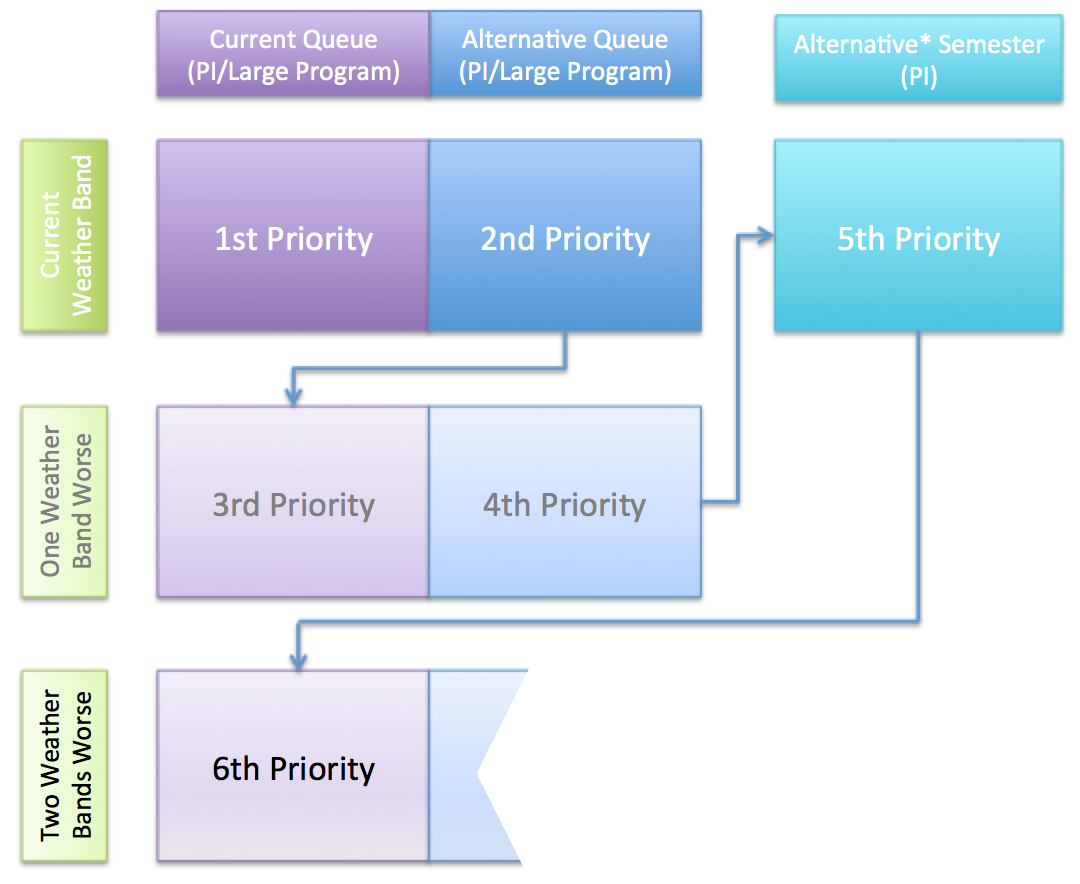In order to maximise productivity, JCMT operations has adopted the concept of flexible scheduling whereby the choice of project observed is determined primarily by:
- the weather conditions and
- the project priority.
To facilitate this we have assigned weather bands to specific ranges of submillimetre opacity (‘tau’):
| Weather Band | Definition | CSO Tau |
|---|---|---|
| 1 | very dry | τ < 0.05 |
| 2 | dry | 0.05 < τ < 0.08 |
| 3 | medium | 0.08 < τ < 0.12 |
| 4 | wet | 0.12 < τ < 0.2 |
| 5 | very wet | 0.2 < τ |
Seeing constraints: Observations at 450μm need seeing less than 1 arcsecond; 850μm less than 2arcseconds (Seeing can be checked at SMA – – – although which value published after “Phase Monitor” is most useful is (20160307) under debate). The following guidelines assume a single queue for all except U.Hawaii projects:
Observers are invited based on the demands of their programs, and because of the program rank as assigned by the TAC. If the weather is suitable, and (new, 20160120) if the scheduled observers are present at the telescope or at JROC (the JCMT Remote Operations Center) in Hilo, or at the remote observing station at HP (‘HROC’), then they may observe targets from their own projects. If the scheduled observers are not present or if it is not possible to carry out this ‘scheduled‘ program for some reason (e.g. weather constraints, program completion, target availability), then alternative targets/projects should be sought, as follows:
- Seek an alternate project of the same type as is scheduled (PI or Large).
- Choose the highest-ranked project appropriate for the current weather conditions (both PI and Large programs have associated rankings).
- As conditions change, new projects must be sought and new MSBs executed. Judging when to switch projects is left to the TSS and observing team to decide.
- Do not abort or interrupt the current observation to change projects unless, e.g. it has just started and will otherwise run for a long time, or because the change in weather is dramatic and certain.
- Changing projects may also mean changing receivers, which will incur additional overheads for pointing, calibration etc. It is thus preferable to stay with the same instrument if priorities allow. For these and other reasons it is difficult to prescribe the precise conditions under which changing the project becomes inevitable.
- In the absence of suitable projects of the same type (PI or Large) follow the guidance shown below:
Notes
- – in the above guidelines Alternative* Semester means either the previous semester (typical for the first four months within a semester) or forwards to the next semester (typical for the last month or two in a semester providing PIs have submitted project MSBs).
- When the scheduled time is to service the University of Hawaii, and if the conditions are not suitable for any of their programs in the current semester, then fallback should be to a mix of EAO PI & EAO LAP programs, in roughly equal measure. It is also possible that special arrangements may be made to observe UH projects from previous semesters, or in conditions that are less than optimal; please check with the JCMT Scheduler and/or the UH contact for details.
Target of Opportunity
Ever so often a Target of Opportunity (ToO) project may be approved, and await triggering.
- If the ToO is triggered (information of which will come from the Telescope Scheduler or, at times, directly from the PI) then it immediately assumes top priority within the approved weather bands.
- Non-UH ToO projects will not override UH observing and so the observing of any ToO triggered during a UH observing block will need to be negotiated with the UH observer. If the ToO is observed, the Scheduler will ensure that the UH queue is paid back any time lost due to executing the ToO.




